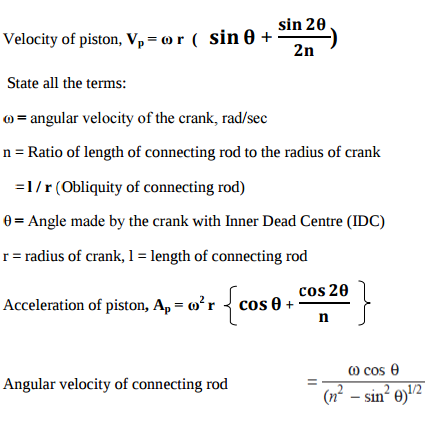Explain the inter-relation between linear and angular velocity, linear and angular acceleration with suitable example.




Crank and slotted lever quick return motion mechanism. This mechanism is mostly used in shaping machines, slotting machines and in rotary internal combustion engines. In this mechanism, the link AC (i.e. link 3) forming the turning pair is fixed, as shown in fig. The link 3 corresponds to the connecting rod of a reciprocating steam engine. The driving crank CB revolves with uniform angular speed about the fixed centre C. A sliding block attached to the crank pin at B slides along the slotted bar AP and thus causes AP to oscillate about the pivoted point A.
Sl. No
Machine
Structure
1
All parts / links have relative motion
No relative motion between the links
2
It transforms the available energy into some useful work
No energy transformations
3
The kinematic link of a machine may transmit both power and motion
The member of the structure transmit forces only
4
Examples: I.C. Engine, Machine tools, steam engine, type writer, etc.
Example: Truss of roof, frame of machine, truss of bridge
(Types of clutches: Two marks, applications Two marks) Types of clutches: a) Single plate clutch b) Multi plate clutch c) Cone clutch d) Centrifugal clutch Applications: a) Single plate clutch: Heavy vehicles, four-wheeler such as car, truck, bus b) Multi plate clutch: Two wheelers, mopeds, scooters, bikes c) Cone clutch: Machine tools, automobiles, press work d) Centrifugal clutch: mopeds, Luna
The process of providing the second mass in order to counter act the effect of the centrifugal force of the disturbing mass is called balancing. In order to prevent the bad effect of centrifugal force of disturbing mass, another mass (balancing) is attached to the opposite side of the shaft at such a position, so as to balance the effect of centrifugal force of disturbing mass. This is done in such a way that the centrifugal forces of both the masses are made equal and opposite.
The function of governor is to regulate the mean speed of the engine, when there are variations in the load. Governor automatically adjusts and controls the supply of fuel / working fluid to the engine with the varying load conditions and keeps the mean speed within the certain desired limits. e.g. When the load on an engine increases, its speed decreases, therefore it becomes necessary to increase the supply of fuel or working fluid. The configuration of the governor changes and valve is moved to increase the supply of working fluid. Conversely, when the load on the engine
Fluctuation of speed: It is the difference between the maximum and minimum speed of Flywheel. Fluctuation of speed = (N1 – N2) rpm N1 – maximum speed, N2 -- minimum speed Fluctuation of energy: It is the difference between the maximum and minimum energy of Flywheel. Maximum energy of Flywheel I ω1 2 Minimum energy of Flywheel = I ω2 2 Fluctuation of energy = I (ω1 2 - ω2 2 ) in N-m or J I – moment of inertia of flywheel = mk2 where, m – mass of the flywheel, kg and k - radius of gyration of flywheel, m2 ω1 – Maximum Angular velocity, rad/sec ω2 – Minimum Angular velocity, rad/sec
1. Manufacturing cost of chains is relatively high 2. The chain drive needs accurate mounting and careful maintenance 3. High velocity fluctuations especially when unduly stretched 4. Chain operations are noisy as compared to belts.
1. As no slip takes place, hence, perfect velocity ratio is obtained (Positive drive). 2. Chain drive gives high transmission efficiency (up to 98 %). 3. Chain drive may be used when the distance between the shafts is less. 4. Chain is made up of metal which would occupy less space as compared with belt or rope drive. 5. Ability to transmit power to several shafts by one chain. 6. Load on the shaft is less and long life.
1. According to the surface in contact: Knife-edge follower Roller follower Flat faced or mushroom follower Spherical follower 2. According to the motion of the follower: Reciprocating or translating follower Oscillating or rotating follower 3. According to the path of motion of follower:
Radial follower Off-set followe